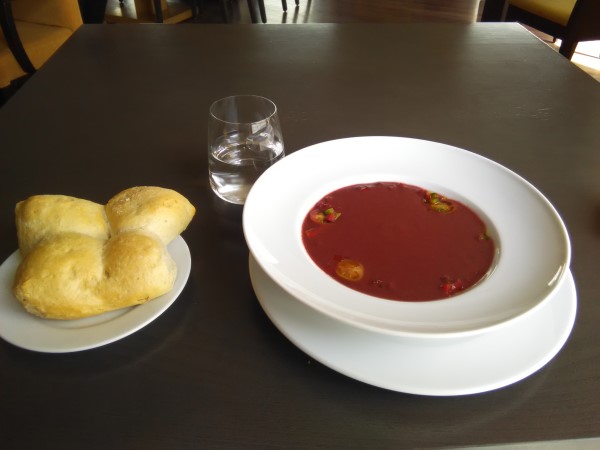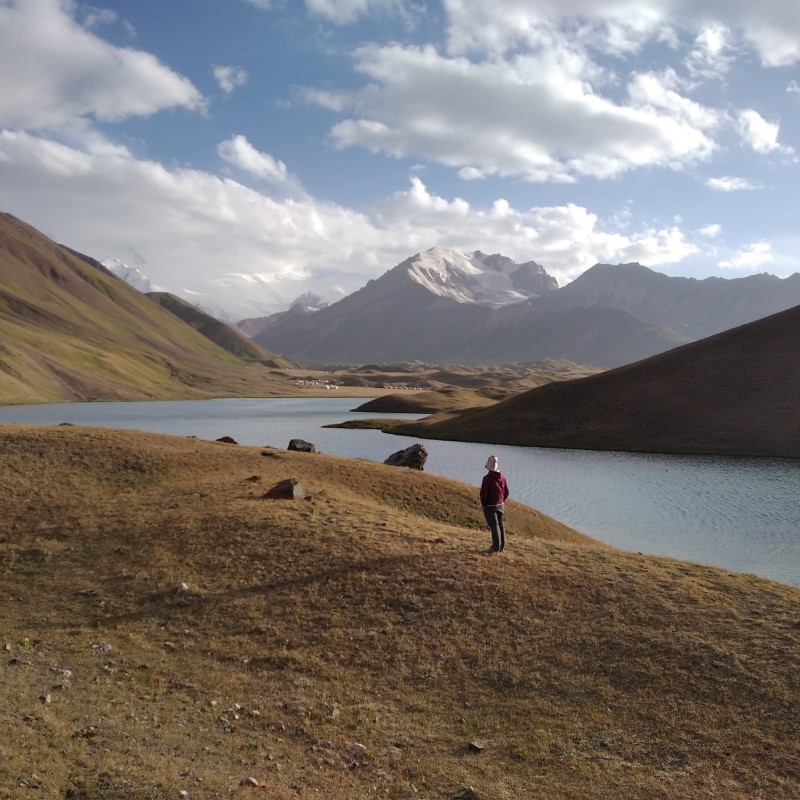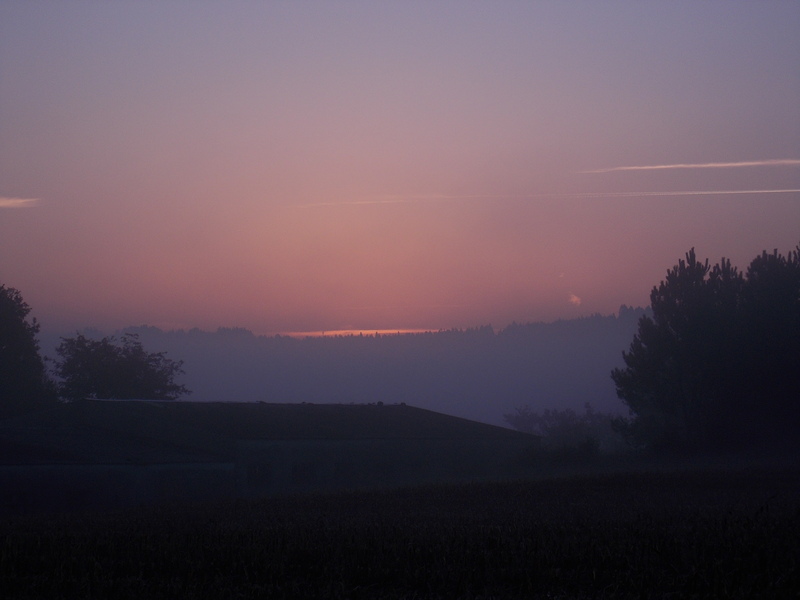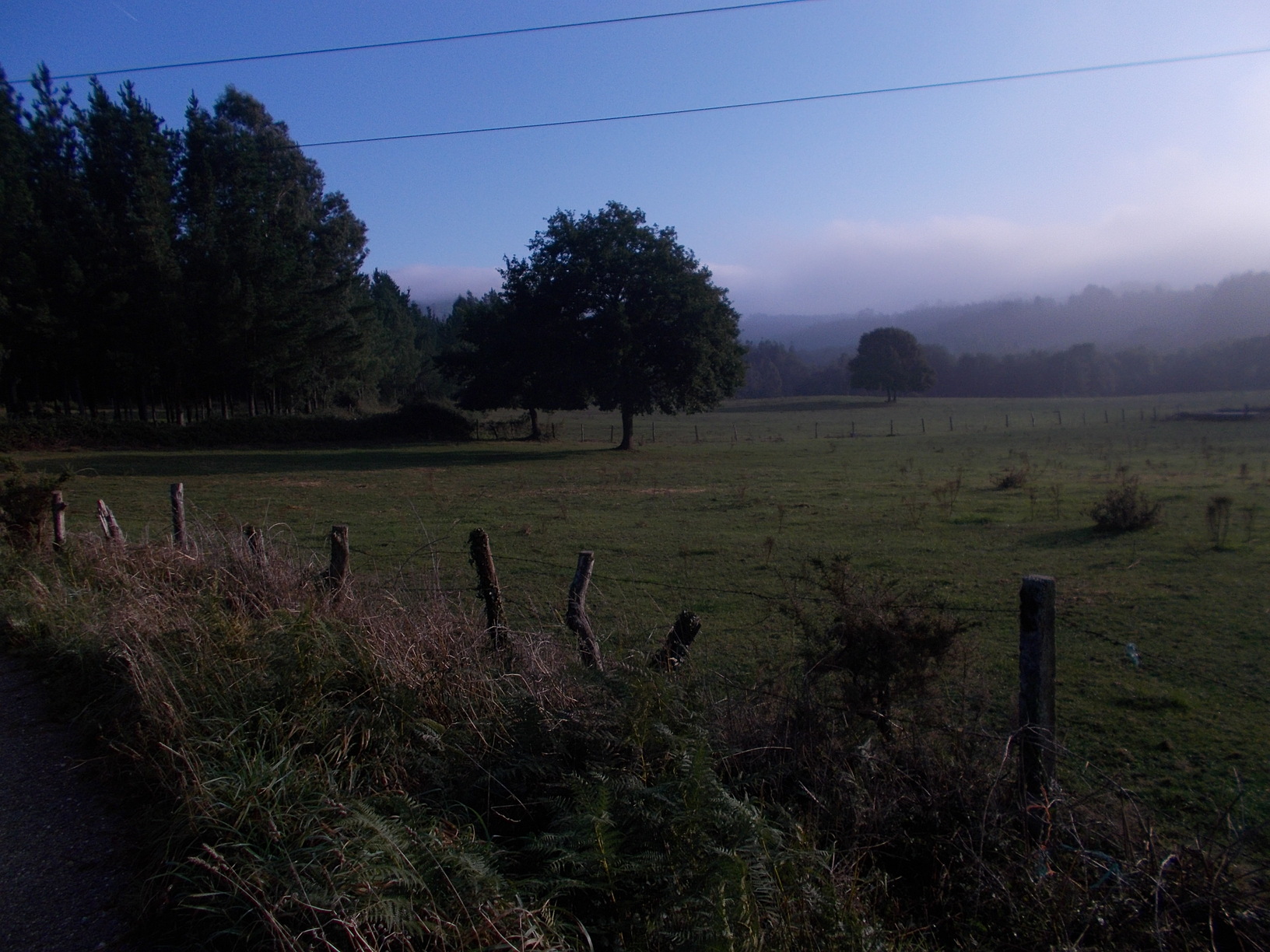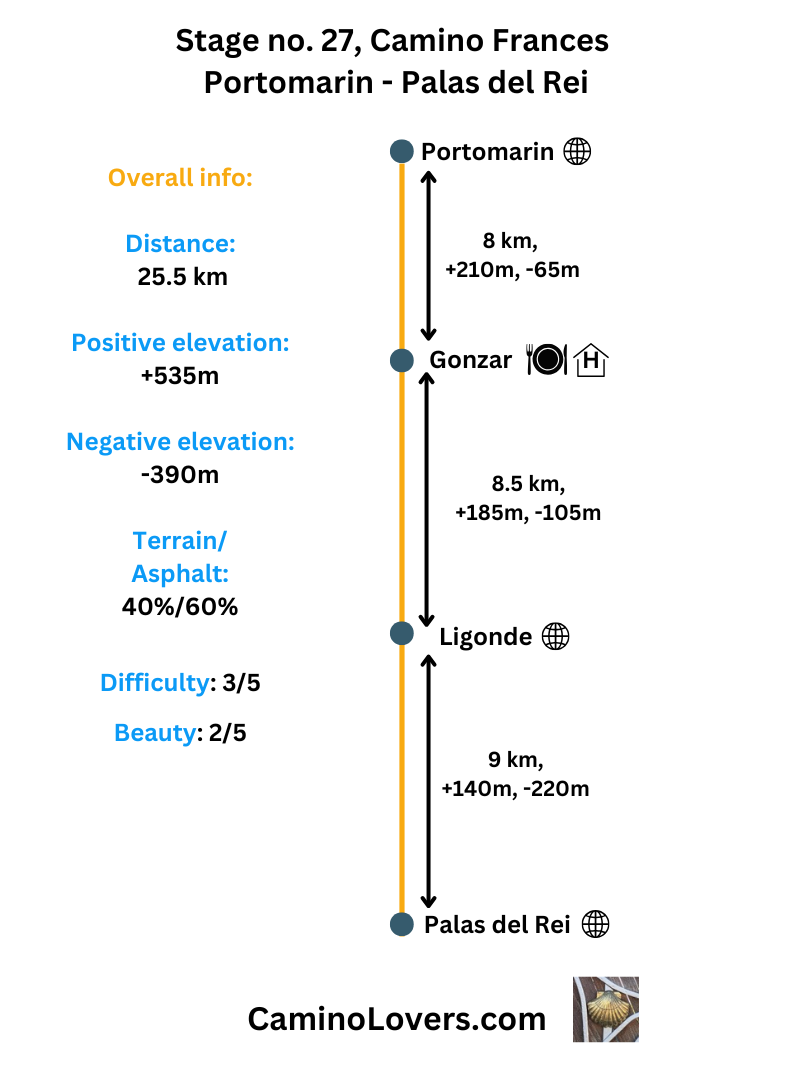
Basic Information
- Starting Point: Portomarín, Spain (350m). A reconstructed medieval town relocated when the Miño River was dammed. With roughly 1,200 inhabitants, the town lives almost entirely from the pilgrims. Count with 15 pilgrim hostels (no doubt other opening soon), plus various hotels, pensions, etc, to accommodate pilgrims on organized bus tours and similar groups. All services and plenty of restaurants.
- Ending Point: Palas de Rei, Spain (540m). Another Galicean town that has been depopulating slowly (going all the way down from 13,000 inhabitants to current 3,000), but is experiencing a bit of revival because of the Camino Frances. Several nice buildings and all infrastructure for pilgrims, including twelve pilgrim albergues. There are nicer towns on the camino, but most people stay here simply because of the comfortable walking distance from the previous important town on the way.
- Availability of an alternative route: No. Today there aren’t any alternative routes/trails that you could follow. Even the long-distance cycling route EV3 copies the camino route almost to the point.
- Distance: 25.5 km (Download GPS here).
- Online Map: map.
- Elevation Difference: +535m ascent, -390m descent.
- Difficulty Score: 3/5.
- Beauty Score: 2/5. Some nice Galicean farmland and oak forests, but too much walking on the road or close to it.
- Terrain/Asphalt Ratio: 40% trails, 60% asphalt, on the road, or close to the road.
- Next stage: Camino Frances Stage no. 28, Palas de Rei – Arzua.
- Previous stage: Camino Frances Stage no. 26, Sarria – Portomarin.
Elevation profile for the route

– As you can see on the chart, today is a different story than yesterday. From km 1 to km 10,5 you climb, more or less gradually, 350 meters. Except of the final push the climb isn’t steep though, with climb gradient rarely surpassing 4%. From then on you walk mostly on the plateau, with some short yet steep descents, eventually taking you all the way down to Palas de Rei.
Advanced Info About the Stage
- Trail Marking: With granite kilometer markers more or less every 500 meters, sometimes even more frequent, and the constant flow of pilgrims in the direction of Santiago, there is no way of getting lost on this stretch. Even if you miss some turn when the camino leaves the provincial road LU-633, it isn’t a big issue, since the camino always connects back to the road in a little while.
- Natural Highlights: Nothing worth a special mention, but there are nice stretches with old oak trees along the route, and some nice “tree tunnels” as well (see the picture below).
- Historical & Cultural Highlights:
- Castor de Catromaior, One of the most important archeological site from Iron age in Spain, ruins of a former fort, more than 2,000 years old, very well preserved. Just 30 meters detour from the Camino, it is a pity many pilgrims miss it (maybe that’s the curse of the last 100 kilometers). Location and reviews on Google maps here.
- Cruceiro de Lameiros. One of the most interesting stone crosses on the entire camino, dating all the way back to 1670. Little by little it is becoming the “Cruz de Ferro” of the last 100 kilometers of Camino Frances, with people leaving stones, shells, messages, etc on the spot. Definitely a nice spot to reflect a bit on your way, and perhaps share a thought or prayer for someone close to your heart… Location and reviews on Google maps here.
- The center of Palas de Rei. Nothing breathtaking, but a decent place for an afternoon stroll without a backpack. As it is always the case on these last 100km of Camino Frances, I recommend you taking an afternoon stroll during siesta hours (between 3pm and 5pm), to avoid the crowds and the places being full of people.
- Camping/Bivouac Options: There are no official campsites along today’s stage, free or paid. It is also tricky with wild camping, since when you walk outside of villages almost all land is private farmland, fenced. What’s more, the small churches and chapels you pass by today do not really have a covered porch, simply a place where one could bivouac in peace at night. With all of that being said, it the high season it isn’t uncommon for people to sleep in the streets of Palas de Rei (or the border areas of the town), simply because they cannot find a bed in the albergues. Police tolerates this, of course as long as you behave nicely and do not disturb the locals at night with your behavior. Just make sure to avoid private property for your sleep.
- Dog-Friendly Score: 3/5. Enough shade and forest sections, with plenty of water as well. On the other hand, there’s a lot of road walking, and several reports of unleashed farm dogs roaming freely in the zone of Gonzar (km 8 of today’s walk). Take precautions in this zone, and if you see an unleashed dog, feel free to scream, since the owners are often nearby, and can take care of it. When it comes to dog-friendly accommodation, I recommend the following places in Palas de Rei: Albergue Buen Camino (they accept dogs on the terrace), location and reviews on Google maps here; Alebrgue Meson de Benito (in low season they always accept dogs, in high season call in advance to make sure), location and reviews on Google maps here.
- Special Remarks: None.
My picks for accommodation on this stage
- Albergue La Fuente del Peregrino, Ligonde (km 16.5). A very small, donation based albergue in the middle of the stage, ideal place to sleep when you try to avoid the crowds. Run by a Christian association, you can count with a delicious communal dinner and breakfast, all donation based (make sure to support the place well, if you can afford it). 9 beds in two rooms, check-in from 1pm, officially they do not accept reservations, but you can try your luck on the following phone number: +34 687 550 527 . In my opinion, it is one of the three best albergues on the last 100 kilometers on Camino Frances, so definitely worth a stop. Don’t worry if you’re not a Christian. They will welcome you with open heart nonetheless.
- Albergue de Peregrinos Palas de Rei (km 25.5). The municipal albergue in Palas de Rei, 60 beds in 5 rooms, 10 euro/night. Opens at 1pm, doesn’t accept reservations. Realistically in high season you have to be there before noon (and wait sitting next to your backpack), to have a chance of getting one of the beds. Location and reviews on Google maps here. Just as it is the case with public albergues in Galicia, while there is a kitchen, there isn’t anything in it for you to actually cook something. But they maintain the albergue decently clean, and it isn’t a bad place for people who walk without making reservations.
- Albergue San Marcos, Palas de Rei (km 25.5). Quiet location near church, modern and spotlessly clean, perhaps the nicest albergue in Palas de Rei. 60 beds in 10 rooms, 20/night. Well-equipped kitchen, nice communal area both inside and outside, friendly hosts. Check-in from noon, you can make a reservation directly on Booking.com, exactly here.
Pictures from the stage
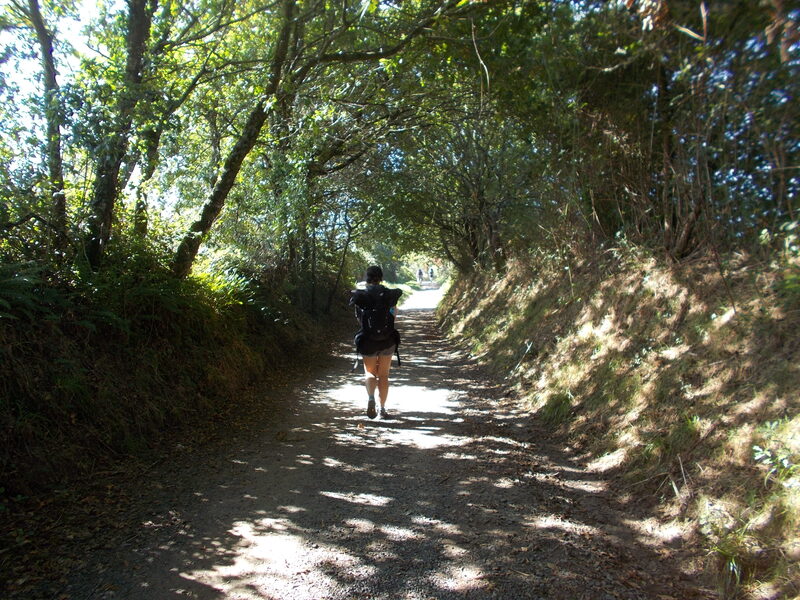 – The “tree tunnels”, so typical for many areas of Galicia. A tired pilgrim can really appreciate them on a hot sunny day.
– The “tree tunnels”, so typical for many areas of Galicia. A tired pilgrim can really appreciate them on a hot sunny day.
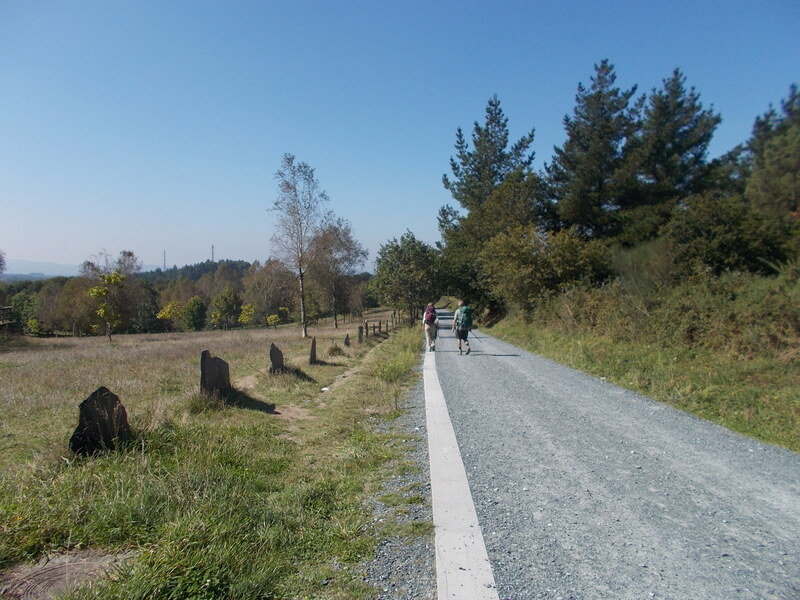 – There’s too much asphalt and road walking on this stage, but some parts are not bad. Just make sure to walk without music and watch for approaching cars.
– There’s too much asphalt and road walking on this stage, but some parts are not bad. Just make sure to walk without music and watch for approaching cars.
Few Tips at the end
- To avoid the crowds and stress, sleep in the middle of stages. The best albergue on this stage is on km 16.5, in Ligonde. But also the albergue in Gonzar (km 8) is pretty decent… If you do not like the stress of making endless phone calls to get a bed, or having to reserve months in advance, it is much better staying in one of these places, and then seek something else in the middle of the next stage. This way you still enjoy the towns passing through them (and doing so during hours when there aren’t many pilgrims around), and at the same time you avoid the stress and the crowds that sleeping in tho camino hot-spots brings.
Next/Previous Stage
- Next stage: Camino Frances Stage no. 28, Palas de Rei – Arzua.
- Previous stage: Camino Frances Stage no. 26, Sarria – Portomarin.
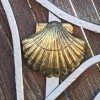


![Ultralight Packing List for Camino de Santiago [2025 Edition]](https://caminolovers.com/wp-content/uploads/2022/03/altra-shoes-640-x-480.jpg)
